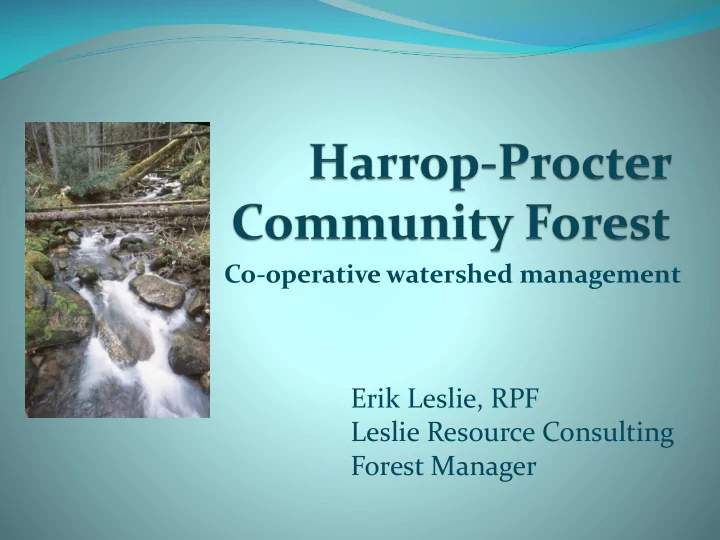

Co-operative watershed management Erik Leslie, RPF Leslie Resource Consulting Forest Manager
Outline 1. Introduction to HP Community Forest 2. Management objectives 3. Forest management approach 4. Market-based instruments 5. Opportunities and barriers 2
3
4
The Harrop-Procter Forest 11,000 ha Domestic watersheds Sensitive terrain 100 year old forests Douglas-fir, larch, pine, spruce-balsam, cedar/ hemlock Very little logging on Crown land 5
The Harrop-Procter Community Diverse rural population Concerns about industrial clearcutting in watersheds Advocated for local control since 1970’s Many advocated for protected status Strong-willed and persistent, organized, volunteer spirit
1980’s and 90’s: The ‘War in the Woods’
Harrop-Procter Community Co-op Harrop-Procter Watershed Protection Society: successful CF application 1999 HPCC incorporated in 2000 Member-owned co-operative, board elected directly from community Board includes small business owners, accountant, ecologist, former tree planters, timber framer, carpenter, retired physiotherapist, beekeeper/ blueberry farmer, mechanic.
Forestry operations
Value-added (lumber) operations
BC Community Forest Program Provincial pilot program initiated in 1998, recognition of need to diversify tenure system 88 communities expressed interest Ten successful pilot applicants Currently 58 communities involved in program Range in size from 1,000 to 85,000 hectares 1.5% of provincial AAC 25 year replaceable forest tenure
2 . Management objectives
HPCC/ HPWPS objectives Watershed protection Protect water quality, quantity, timing of flow Ecologically-based forest management Maintain biodiversity and ecological integrity Multiple use (not just timber) Promote local employment Model of progressive, alternative forest management approach
BBWMP objectives (2.1.4 and 2.4.4) Lands are managed with source water protection as the highest priority Integrated landscape management principles are applied to all land management decisions Landscapes support healthy ecosystems with and abundance of economic, aesthetic and recreational opportunities Land is conserved / managed for multiple uses with minimal impact on water — protect ecological integrity
Climate Change : Adaptive management Ecosystems are dynamic wildfire, insects, disease Change is inevitable, rate of change will increase Hotter, drier summers More extreme disturbances Evolving understanding of ecosystem ‘health’ and ‘ecological integrity’ objectives Implementing objectives will require adaptive, flexible approach
3. Management approach Ecosystem-based, precautionary Comprehensive reserve network Zoning for multiple uses Site-sensitive logging, partial cutting
“Ecosystem - based” approach Focus on ecological functions and integrity Natural disturbance regimes, forest composition and structure Landscape ecology, conservation biology Precautionary principle — reserves, lower harvest level Balanced activities, social/ community well-being
Reserve network Multiple spatial scales Landscape Site/ stand Sensitive sites Soils Terrain Riparian Old growth forests Rare ecosystems Caribou habitat 18
Zoning Multiple forest uses Recreation NTFP harvest Cultural areas Connectivity corridors Riparian zones Wildland-urban interface zone Landscape-level fuel breaks 19
Site-sensitive logging 20
4. Market-based instruments
FSC certification Voluntary market branding Integral to HPCC business plan Forest Stewardship Council certified since 2003 Niche market Logs Lumber — added value Price premium (5 – 10%)
Other market-based instruments Carbon offsets Pacific Carbon Trust —provincial ‘carbon neutral’ commitment Voluntary carbon offsets market Cap and trade would increase price / tonne CO2 Ecosystem services If ‘public goods’ were monetized (e.g., water, fire protection, visual quality, wildlife habitat)
5. Opportunities and barriers
Barriers Tenure system focused on timber Log and lumber markets are very competitive and volatile Limited market-based incentives for improved management for non-timber values Poor economies of scale Hard to access capital
Opportunities Diverse, niche markets available Small scale vertical integration can be efficient Novel approaches possible, if flexible People want to support sustainable, community-based enterprises
Erik Leslie, RPF Thank you! erikl@netidea.com office (250) 229-2221 www.hpcommunityforest.org 27
Recommend
More recommend